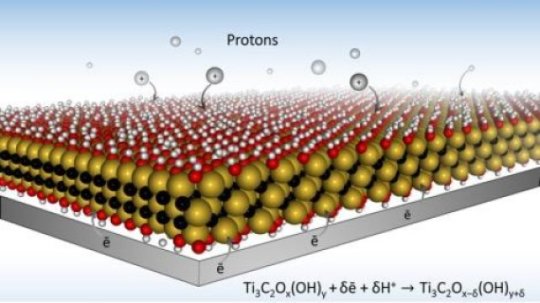 Drexel University researchers have developed two new electrode designs, using MXene material, that will allow batteries to charge much faster. The key is a microporous design that allows ions to quickly make their way to redox active sites. Image credit: Drexel University
Drexel University researchers have developed two new electrode designs, using MXene material, that will allow batteries to charge much faster. The key is a microporous design that allows ions to quickly make their way to redox active sites. Image credit: Drexel University
We know how annoying and stressful it is to charge your smartphone when it has lost its charge. You have to wait too long for the device to be operational again. Now, imagine that you can charge it in just a few seconds.
The speed of charging a battery is a function of the voltage and/or the current applied to it. Theoretically, you can either increase the voltage or the current being supplied during the charging cycle in order to reduce the charging time. Increasing the voltage (which is equivalent to increasing the current for a fixed resistance), however, is a bad idea. Your battery can catch fire. Increasing the current is also not very practical because the manufacturer sets a limit on the size of the current because chemical batteries do not have enough storage to keep the charges produced by the current.
These storage locations are ports called "redox active sites" and they are located in the electrodes. Thus, if we can create electrodes with materials that have more ports, we can store more energy. At the same time, electrodes with more ports will allow ions to quickly fill the ports without interference. However, changing the type of electrodes that hold more ports has been an elusive task, until now.
A team of researchers at Drexel University in Philadelphia, led by Yury Gogotsi, Ph.D, Distinguished University and Bach Professor in Drexel's College of Engineering in the Department of Materials Science and Engineering, created a new electrode design from a two-dimensional, highly conductive material called MXene that was discovered by researchers in Drexel's Department of Materials Science and Engineering in 2011. The results of the research were published on July 10, 2017, in the journal Nature Energy.
"This paper refutes the widely accepted dogma that chemical charge storage, used in batteries and pseudocapacitors, is always much slower than physical storage used in electrical double-layer capacitors, also known as supercapacitors," Gogotsi said. "We demonstrate charging of thin MXene electrodes in tens of milliseconds. This is enabled by very high electronic conductivity of MXene. This paves the way to development of ultrafast energy storage devices than can be charged and discharged within seconds, but store much more energy than conventional supercapacitors."
The idea to improve the speed and storage capabilities of chemical batteries started when Dr. Patrice Simon and Zifeng Lin from Université Paul Sabatier in France, partnered in the Drexel University project. They designed an electrode made of a hydrogel — a hydrophilic polymer — with many redux active sites that allows the storage of as much charge for its volume as a whole battery. Then, the Drexel-led group decided to improve this electrode by creating an architecture that holds many small openings (macroporosity) to ease the path of the ions moving toward the electrodes.
"In traditional batteries and supercapacitors, ions have a tortuous path toward charge storage ports, which not only slows down everything, but it also creates a situation where very few ions actually reach their destination at fast charging rates," said Maria Lukatskaya, a graduate student in Drexel's MAX/MXene Research Group and the first author of the paper, who conducted the research as part of the A.J. Drexel Nanomaterials Institute. "The ideal electrode architecture would be something like ions moving to the ports via multi-lane, high-speed 'highways,' instead of taking single-lane roads. Our macroporous electrode design achieves this goal, which allows for rapid charging — on the order of a few seconds or less."
The results of this development are significant, not only for the improvement of the charging process of smart phones and similar mobile devices, but it also helps to improve the expansion of the electric vehicle charging process. "If we start using low-dimensional and electronically conducting materials as battery electrodes, we can make batteries working much, much faster than today," Gogotsi said. "Eventually, appreciation of this fact will lead us to car, laptop and cell-phone batteries capable of charging at much higher rates — seconds or minutes rather than hours."
An abstract of the journal article can be found here: https://www.nature.com/articles/nenergy2017105

